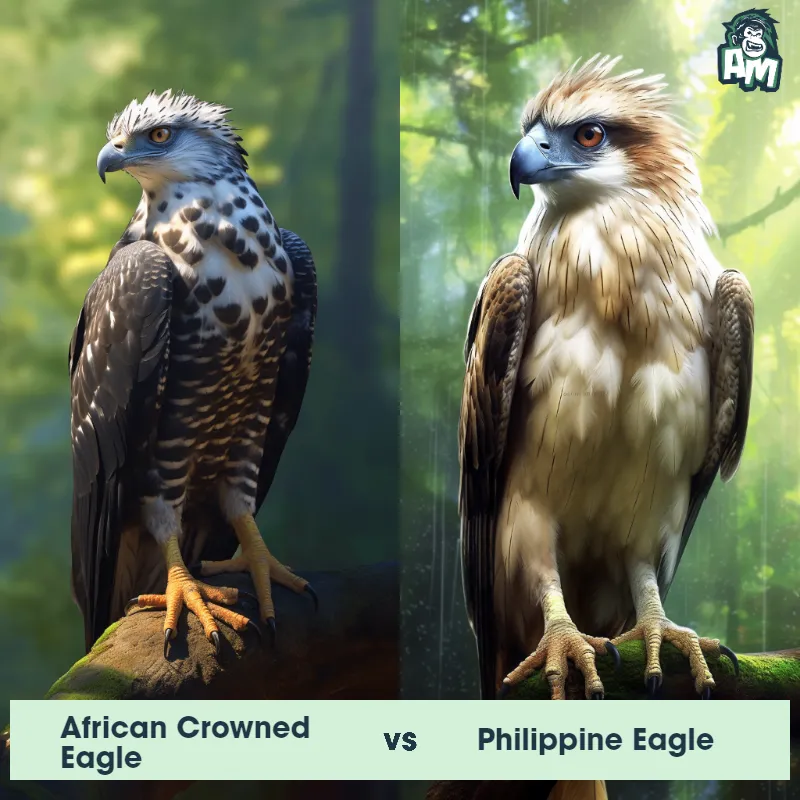The Philippine Eagle
The Philippine Eagle, also known as the Monkey-eating Eagle, is a magnificent bird of prey endemic to the Philippines, particularly in the islands of Luzon, Samar, Leyte, and Mindanao. With a wingspan reaching up to 7 feet, it is one of the largest eagle species in the world. It has striking features, such as a prominent crest of feathers and piercing blue eyes. Its plumage is predominantly dark brown, with a creamy white underbelly. The Philippine Eagle primarily feeds on monkeys, small mammals, birds, and reptiles, making it a formidable predator in the forest canopy.

| Philippine Eagle | |
|---|---|
| Size | Up to 3 feet (91 cm) tall, wingspan up to 7 feet (213 cm) |
| Weight | Up to 20 pounds (9 kg) |
| Speed | Speed: 50 mph (80.47 km/hr) |
| Key Strength | Powerful talons and sharp beak |
| Biggest Weakness | None |
| Scientific Name | Pithecophaga jefferyi |
| Family | Accipitridae |
| Habitat | Tropical forests |
| Geography | Endemic to the Philippines |
| Diet | Primarily monkeys, flying squirrels, and other small mammals |
| Lifespan | 30 years - 60 years |

The Philippine Eagle
The Philippine Eagle, also known as the Monkey-eating Eagle, is a magnificent bird of prey endemic to the Philippines, particularly in the islands of Luzon, Samar, Leyte, and Mindanao. With a wingspan reaching up to 7 feet, it is one of the largest eagle species in the world. It has striking features, such as a prominent crest of feathers and piercing blue eyes. Its plumage is predominantly dark brown, with a creamy white underbelly. The Philippine Eagle primarily feeds on monkeys, small mammals, birds, and reptiles, making it a formidable predator in the forest canopy.
Fun Fact: The Philippine Eagle is considered one of the world's rarest and most critically endangered raptors, with only an estimated 400 pairs left in the wild due to habitat loss and hunting.
| Philippine Eagle | |
|---|---|
| Size | Up to 3 feet (91 cm) tall, wingspan up to 7 feet (213 cm) |
| Weight | Up to 20 pounds (9 kg) |
| Speed | Speed: 50 mph (80.47 km/hr) |
| Key Strength | Powerful talons and sharp beak |
| Biggest Weakness | None |
| Scientific Name | Pithecophaga jefferyi |
| Family | Accipitridae |
| Habitat | Tropical forests |
| Geography | Endemic to the Philippines |
| Diet | Primarily monkeys, flying squirrels, and other small mammals |
| Lifespan | 30 years - 60 years |
Philippine Eagle Matchups
We use AI to simulate matchups between the Philippine Eagle and other animals. Our simulation considers size, strength, and natural predatory behaviors to determine the most likely outcome.

Can't find the Matchup you want?
Create Your Own MatchupPhilippine Eagle: Diet, Predators, Aggression, and Defensive Behaviors
What do Philippine Eagles eat?
Philippine Eagles are carnivorous birds that primarily feed on monkeys, snakes, flying lemurs, birds, and other small mammals. They are at the top of the food chain in their ecosystem and play a crucial role in maintaining the balance of their habitat.
Do Philippine Eagles have any predators?
As apex predators, adult Philippine Eagles do not have natural predators in the wild. However, their eggs and young chicks are vulnerable to various threats such as other raptors, large snakes, and humans who may disturb or harm their nests.
Are Philippine Eagles aggressive?
While Philippine Eagles are known to be territorial and will defend their nests, they are not generally considered aggressive towards humans unless provoked or threatened. They are known to be attentive parents and fiercely protect their offspring.
Do Philippine Eagles fight?
Philippine Eagles are known to engage in territorial disputes with each other and other bird species. These fights can be intense and may involve aerial combats, vocalizations, and physical attacks using their powerful talons and beaks.
How do Philippine Eagles defend themselves?
When threatened or in conflict, Philippine Eagles will rely on their sharp talons, strong beak, and agile flight skills to defend themselves. They may also use vocalizations and intimidating displays to ward off potential threats and protect their territory.
What is the biggest weakness of Philippine Eagles in a fight?
Despite their strength and honed hunting instincts, Philippine Eagles are vulnerable to human activities such as habitat destruction, hunting, and illegal wildlife trade. These threats pose a significant risk to their population and survival in the wild, making them highly susceptible in human-induced conflicts.
Fun Fact: The Philippine Eagle has a unique call that resembles a loud, high-pitched whistle, which can carry over long distances and is often attributed to its nickname, the "Monkey-eating Eagle."
Fun Fact: The Philippine Eagle is known for its impressive hunting skills, as it is capable of swooping down and capturing prey with its strong talons at speeds of up to 50 miles per hour.


















